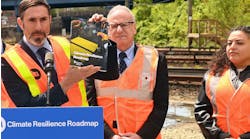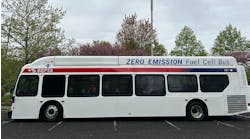Mar. 20—A group of city officials visited three Western states this month to learn about the potential impact of rapid transit systems across Montana — and, in Missoula, to address connectivity in the city's midtown area.
Missoula Mayor Andrea Davis and city council members Mirtha Becerra and Mike Nugent, along with Montana Department of Transportation officials and city staff, looked at different systems in cities similar to Missoula, while seeking information about how to develop a rapid transit hub along Brooks Street.
The fact-finding team visited Fort Collins, Colorado; Vancouver, Washington; and Eugene, Oregon.
"Imagine the opportunity that can be opened up for Missoulians when there is actually a bus line running up and down one of our busiest streets," Davis told the Missoulian. She visited only Colorado because of time restrictions. "People would not only be able to walk from adjacent neighborhoods, but then also access retail and businesses by the same means."
Rapid transit systems are similar to a light rail system but with buses. Rapid transit lines would have more frequent pickup times and each station would have stronger pedestrian infrastructure.
It's important to note that the rapid transit does not act as "high speed" transit, but instead times out traffic patterns for more predictable coverage and shorter wait times.
Missoula has launched a study called "Transform Brooks/Connect Midtown," which is looking into whether a rapid transit system can be installed from the Brooks/Reserve intersection leading toward downtown.
A similar but separate study called the "Midtown Master Plan" has already been created to better explore greenways, places for increased development and park space around the Brooks Street corridor.
Nugent said his biggest takeaway from the trip was the flexibility of rapid transit. Some routes in the cities visited used their own dedicated lanes and some used the public road, while others combined the two.
"It just illustrated that there's a lot of pieces that Missoula has going for it that we can do something like this," Nugent said.
Becerra said the trip was a good way to learn about how other cities have initiated rapid transit.
In Eugene, which features the first BRT (bus rapid transit) in the United States, city officials have also finished a second line in the last couple years, making adjustments based on evaluations of the first line.
In Fort Collins, much of the rapid transit system was designed to navigate on its own lane, sometimes taking a route off the street and behind major buildings.
Vancouver made a mix of both dedicated lanes and routes in public traffic.
"We here in Missoula are going through a number of planning processes and I think it's a great opportunity and a great time to think about transit and land use together," Becerra said.
Eventually, Davis said the rapid transit system could connect some of Missoula's most car-reliant neighborhoods, like Brooks and Reserve streets, or even to Missoula Montana Airport.
Yet, there are two things that stand in the way: A proper rapid transit design and the money to pay for it. Missoula is roughly two-thirds of the way through the Transform Brooks/Connect Midtown plan.
The plan still needs to develop a specific route for the rapid transit, including whether buses would get a dedicated lane on Brooks, or where the system should connect into the downtown transfer station.
A final decision could come sometime this year. Additionally, the money to pay for a new system would likely cost millions, and the city has no way to fund the project.
But Becerra noted that this plan isn't for a project next year, but planning for the next three decades. She said with proper planning, the rapid transit could tie in the midtown around Brooks.
"This would be a huge investment," Becerra said. "Thinking ahead 10 to 15 years down the road, how is that going to function for us so that we make the right investment and not having to back up five years to say, 'Oh, we should really fix this or do something differently.'"
Davis added that the city is hoping to change the age-old malfunction junction title to the "midtown junction" in the future.
The city paid for the fact-finding trips by allocating up to $25,000 in Tax Increment Financing from the Missoula Redevelopment Agency. Montana Department of Transportation and Mountain Line employees paid from their respective budgets.
___
(c)2024 Missoulian, Mont.
Visit Missoulian, Mont. at http://www.missoulian.com
Distributed by Tribune Content Agency, LLC.


